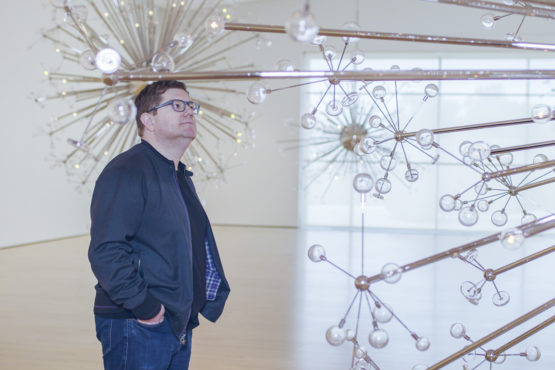First West Coast exhibition of monumental installation melds art and science at Stanford’s Cantor Arts Center
Island Universe brings physicist’s theories home in a stunning presentation.
A new exhibit at the Cantor Arts Center invites viewers to imagine not just one universe, but many.
Working at the unexpected intersection of physics, art and the history of modernism, Josiah McElheny’s monumental installation Island Universe, on view through August 18, 2019, envisions an infinite, multiverse scenario, where five separate universes occupy the same space, frozen in their individual moments of expansion.
Go to the web site to view the video.
The sculptural work, made of brilliantly polished chromed metal, handblown glass and radiating lights, is a marriage of scientific research and artistic vision. McElheny collaborated closely with David Weinberg, chair of the Department of Astronomy at Ohio State University, to conceptualize and make the necessary calculations needed for the installation’s forms. Their collaboration took place beginning in 2004 while McElheny was a resident at the Wexner Center for the Arts at Ohio State.
“Bringing Island Universe to the Cantor is meaningful because the project was inspired by the work of Andrei Linde, a renowned professor in the Physics Department at Stanford,” said Susan Dackerman, John and Jill Freidenrich Director at the Cantor. “My hope is that this exhibition encourages conversations among faculty, students and the wider community about how art and science can be linked in visually stimulating and surprising ways and how these two disciplines can inform each other.” The installation at the Cantor is the first time Island Universe has been exhibited on the West Coast.

Josiah McElheny based his monumental artwork on scientific research and artistic vision. (Image credit: Kurt Hickman)
The name of the awe-inspiring work, Island Universe, references the 18th-century German philosopher Immanuel Kant’s speculation about the existence of multiple galaxies, scattered like islands across the universe. The following century, German naturalist and explorer Alexander von Humboldt popularized Kant’s conjecture as the “island universe” hypothesis.
Stanford’s Linde built upon these conceptions of the cosmos when, in 1982, he proposed the idea of an inflationary multiverse – a cosmos without a single point of origin that includes multiple coexistent universes, each with a particular shape governed by unique properties.
“At Stanford, cutting-edge research is taking place every day in an effort to help us better understand both our origins and our future,” Dackerman said. “Art allows us to visualize the intangible and the unknowable. Island Universe is a perfect example of one artist’s view of something impossible to see – the formation of the universe. Bringing this work to the Cantor highlights the role of the museum in the 21st century as a place where the visual and intellectual meet.”
Stanford faculty from both the humanities and sciences will be joined with an art historian for a discussion series about Island Universe. On March 13, Dackerman will be in conversation with Peter Michelson, senior associate dean for the natural sciences and the Luke Blossom Professor in the School of Humanities and Sciences. On April 25, Nancy Troy, the Victoria and Roger Sant Professor in Art in the Department of Art and Art History, will be in conversation with Thomas Ryckman, a professor in the Philosophy Department. And on May 30, Aleesa Alexander, assistant curator of American art at the Cantor, will be in conversation with Elizabeth Kessler, a lecturer in the American Studies Program and the American Studies program coordinator. These events will be part of the Cantor’s Case Studies program.
Expanding science, expanding art
When the first physical evidence of the big bang theory became public in 1965, it launched popular interest in space science. That same year, artisans in Vienna created the iconic chandeliers of the Metropolitan Opera in New York. The confluence of those two events inspired McElheny, who many years later modeled Island Universe on the chandeliers and incorporated the notion of an expanding universe with a careful placement of metal spheres, lights, glass disks and globes that make up the work. “The whole project,” McElheny wrote, “exists at the intersection of specific concepts and abstract ones.”
McElheny, born in Boston, Massachusetts, in 1966, lives and works in New York City. The 2006 MacArthur Fellow combines his skills as an expert glassblower, which he honed for many years by learning from European masters, with a playful approach to both the history of his medium and the history of ideas. His objects and installations, often inspired by historical events, seek to fuse materiality and thought in the experience of viewing a work of art.
The glass disks and globes that are part of Island Universe were hand-blown by the artist, who is recognized for his conceptually rigorous approach and his physical mastery of materials. He once said that using glass in his work gives a unique perspective not because the glass itself is important, but because of what viewers see through it.
In addition to the installation, the exhibition includes the film Island Universe that was shot on-site at the New York Metropolitan Opera House in 2005. The predominately black screen is occasionally illuminated by an “explosive” light from the iconic chandeliers that invites comparisons between the grandiosity of the chandeliers and the ever-changing nature of the cosmos. Stills from the film have also been reprinted with excerpts from the French philosopher Auguste Blanqui in a work called Eternity Through The Stars.
To accompany McElheny’s sculptural works, there are also photographs, drawings and the original Blanqui text. The other works present various relationships between the galaxies and the Lobmeyr chandeliers and provide a window into McElheny’s artistic process.

